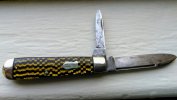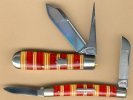-
The BladeForums.com 2024 Traditional Knife is ready to order! See this thread for details: https://www.bladeforums.com/threads/bladeforums-2024-traditional-knife.2003187/
Price is$300$250 ea (shipped within CONUS). If you live outside the US, I will contact you after your order for extra shipping charges.
Order here: https://www.bladeforums.com/help/2024-traditional/ - Order as many as you like, we have plenty.
You are using an out of date browser. It may not display this or other websites correctly.
You should upgrade or use an alternative browser.
You should upgrade or use an alternative browser.
Celluloid Knife Handle Deterioration (Out Gassing)
- Thread starter herder
- Start date
- Joined
- Jun 28, 2016
- Messages
- 447


What are we thinkin? Gassed? Can I flitz that backspring and bolsters?
- Joined
- Jul 30, 2006
- Messages
- 43,904
Has anyone tried active carbon to absorb the gas generated by the celluloid breakdown?
The chemical released by the celluloid as it decomposes is nitric acid. Activated charcoal won't do much with that.
- Joined
- Jan 13, 2003
- Messages
- 6,559


What are we thinkin? Gassed? Can I flitz that backspring and bolsters?
As I mentioned before, very tough to tell whether that is from the knife, or maybe a knife stored next to it at some point. However, the damage is damage. It also looks like the covers are pulling (shrinking), so it may very well be those covers causing the outgassing. Flitz may take that corrosion off, but I think the rust has eaten into the metal now, so there would be scars. It is also my opinion that the knife will continue to deteriorate, even if you clean up the corrosion. It sounds like it is your desire to maintain the knife with those covers. I'm not sure that will be possible.
Glenn
Has anyone tried active carbon to absorb the gas generated by the celluloid breakdown?
The chemical released by the celluloid as it decomposes is nitric acid. Activated charcoal won't do much with that.
One could wash a knife in light detergent. The alkaline nature of the detergent should neutralize the nitric acid and the water base would penetrate the cracks of the knife.
Like your teeth? "Wash your celluloid every day or else your knife may go away.
- Joined
- Jun 28, 2016
- Messages
- 447
Glenn, I see you're not too far from me. Would you be interested in discussing a project for this knife? Could you message me?As I mentioned before, very tough to tell whether that is from the knife, or maybe a knife stored next to it at some point. However, the damage is damage. It also looks like the covers are pulling (shrinking), so it may very well be those covers causing the outgassing. Flitz may take that corrosion off, but I think the rust has eaten into the metal now, so there would be scars. It is also my opinion that the knife will continue to deteriorate, even if you clean up the corrosion. It sounds like it is your desire to maintain the knife with those covers. I'm not sure that will be possible.
Glenn
- Joined
- Dec 19, 2006
- Messages
- 8,210
Here's an article from Journal of the American Institute for Conservation. Haven't read it yet but I'll post the link and read it later.
"CELLULOID OBJECTS: THEIR CHEMISTRY AND PRESERVATION" by JULIE A. REILLY
http://cool.conservation-us.org/jaic/articles/jaic30-02-003.html
"CELLULOID OBJECTS: THEIR CHEMISTRY AND PRESERVATION" by JULIE A. REILLY
http://cool.conservation-us.org/jaic/articles/jaic30-02-003.html
- Joined
- Nov 25, 2016
- Messages
- 3,149
"Celluloid handles do represent an important and beautiful part of knife history and should be preserved as much as possible. " - Herder, c. 2016
Fortunately I was educated by some of the world's greatest knife enthusiasts
https://www.bladeforums.com/threads...erioration-out-gassing.1457872/#post-16780123
Which lead me to this article:
http://www.oregonknifeclub.org/celluloid_02.html
After reading everyone's forum posts last year and the article above, the nerdy engineer in me decided to do a lot of research into celluloid and came to some conclusions, the first conclusion is that the celluloid decomposition cannot be stopped and the second conclusion is that the decomposition rate CAN be controlled but the most important factor starts at the beginning in the making of the celluloid and how "stable" the final product is. Chemistry was far from an exact science back in 1868 when celluloid was first created, so the process to make celluloid literally makes or breaks how well the celluloid will stand up to the real world environment. Celluloid was / is made from combining cellulose nitrate (gun cotton or magician's "flash" paper) with a solvent called camphor, nitric acid, water, stabilizing compounds and intense heat / pressure. Once the celluloid is formed and is removed from the high pressure, the decomposition process will start because although the celluloid seems perfectly solid, it needs that high pressure to stay in that original stable state. Under normal atmospheric pressure the celluloid will break down and start to release the products that put it together in the first place, namely nitric acid and water moisture. The release of those two by-products is what causes the steel blades to begin to rust. Obviously there is not much we can do about atmospheric pressure or how good the chemical composition of the celluloid was to begin with, but there are 4 other factors that we can control to help "slow" the "gassing": 1) Humidity, 2) temperature, 3) light and 4) storage.
Humidity, temperature and light are all pretty self explanatory... all three of them in excess will accelerate the decomposition process. The storage process is probably what catches the knife collection enthusiast off guard the most. As I mentioned previously, when the celluloid breaks down it releases nitric acid and moisture which are key ingredients for rusting metals. If you store a poorly made celluloid scale in a sealed container, then the nitric acid and moisture have no where to escape to. Now if you add a couple of other bone scaled knives in that same sealed container, the nitric acid and moisture does have a place to go and that is into formation of rust on your other blades; this is basically why knife owners say that the "gassing" spreads Many knife collectors like to keep their collections in places they feel are "safe" from the open environment (knife rolls, containers, drawers, etc.) but in the case of celluloid knives, open air is actually your friend along with controlled light, heat and humidity
Many knife collectors like to keep their collections in places they feel are "safe" from the open environment (knife rolls, containers, drawers, etc.) but in the case of celluloid knives, open air is actually your friend along with controlled light, heat and humidity 
So when I buy a celluloid knife the first thing I look at are the signs around the bolster, shield and pins... if they look OK on a knife that is 50+ years old, then the odds are you have a pretty well made celluloid product. After that I store all of my celluloid knives (away from my other knives) on a cedar plank in my temperature/humidity controlled basement on the top shelf of a storage rack with no windows around. So for example, the Electric Cut Co knife I pictured earlier in this thread I bought over a year ago... you can see there is little to no shrinkage and a very slight discoloration on the bolster near the end of the scales so I feel pretty good that this celluloid is well made. In my reading I saw some particular manufacturer's names that were mentioned frequently, Hen & Rooster comes to mind and it may be that they just had a rushed or hurried process in making the celluloid. I have Ulster, NYKC, Schrade family and earlier Imperial celluloids that (knock on wood) I have not had issues to date. Of course I am new and in a year I might have a bunch of example pictures of "gassing" to post for other newbies . With that said, if you have a good celluloid product it IS decomposing right now... however, you can slow that down with proper storage.
. With that said, if you have a good celluloid product it IS decomposing right now... however, you can slow that down with proper storage.
Merry Christmas and let's slow down "gassing"!
View attachment 817487
-Kevin
Fortunately I was educated by some of the world's greatest knife enthusiasts
https://www.bladeforums.com/threads...erioration-out-gassing.1457872/#post-16780123
Which lead me to this article:
http://www.oregonknifeclub.org/celluloid_02.html
After reading everyone's forum posts last year and the article above, the nerdy engineer in me decided to do a lot of research into celluloid and came to some conclusions, the first conclusion is that the celluloid decomposition cannot be stopped and the second conclusion is that the decomposition rate CAN be controlled but the most important factor starts at the beginning in the making of the celluloid and how "stable" the final product is. Chemistry was far from an exact science back in 1868 when celluloid was first created, so the process to make celluloid literally makes or breaks how well the celluloid will stand up to the real world environment. Celluloid was / is made from combining cellulose nitrate (gun cotton or magician's "flash" paper) with a solvent called camphor, nitric acid, water, stabilizing compounds and intense heat / pressure. Once the celluloid is formed and is removed from the high pressure, the decomposition process will start because although the celluloid seems perfectly solid, it needs that high pressure to stay in that original stable state. Under normal atmospheric pressure the celluloid will break down and start to release the products that put it together in the first place, namely nitric acid and water moisture. The release of those two by-products is what causes the steel blades to begin to rust. Obviously there is not much we can do about atmospheric pressure or how good the chemical composition of the celluloid was to begin with, but there are 4 other factors that we can control to help "slow" the "gassing": 1) Humidity, 2) temperature, 3) light and 4) storage.
Humidity, temperature and light are all pretty self explanatory... all three of them in excess will accelerate the decomposition process. The storage process is probably what catches the knife collection enthusiast off guard the most. As I mentioned previously, when the celluloid breaks down it releases nitric acid and moisture which are key ingredients for rusting metals. If you store a poorly made celluloid scale in a sealed container, then the nitric acid and moisture have no where to escape to. Now if you add a couple of other bone scaled knives in that same sealed container, the nitric acid and moisture does have a place to go and that is into formation of rust on your other blades; this is basically why knife owners say that the "gassing" spreads

So when I buy a celluloid knife the first thing I look at are the signs around the bolster, shield and pins... if they look OK on a knife that is 50+ years old, then the odds are you have a pretty well made celluloid product. After that I store all of my celluloid knives (away from my other knives) on a cedar plank in my temperature/humidity controlled basement on the top shelf of a storage rack with no windows around. So for example, the Electric Cut Co knife I pictured earlier in this thread I bought over a year ago... you can see there is little to no shrinkage and a very slight discoloration on the bolster near the end of the scales so I feel pretty good that this celluloid is well made. In my reading I saw some particular manufacturer's names that were mentioned frequently, Hen & Rooster comes to mind and it may be that they just had a rushed or hurried process in making the celluloid. I have Ulster, NYKC, Schrade family and earlier Imperial celluloids that (knock on wood) I have not had issues to date. Of course I am new and in a year I might have a bunch of example pictures of "gassing" to post for other newbies
Merry Christmas and let's slow down "gassing"!
View attachment 817487
-Kevin
Last edited:
- Joined
- Jun 9, 2010
- Messages
- 4,333
Merry Christmas, Kevin. Good post with interesting points."Celluloid handles do represent an important and beautiful part of knife history and should be preserved as much as possible. " - Herder, c. 2016
Fortunately I was educated by some of the world's greatest knife enthusiasts
https://www.bladeforums.com/threads...erioration-out-gassing.1457872/#post-16780123
Which lead me to this article:
http://www.oregonknifeclub.org/celluloid_02.html
After reading everyone's forum posts last year and the article above, the nerdy engineer in me decided to do a lot of research into celluloid and came to some conclusions, the first conclusion is that the celluloid decomposition cannot be stopped and the second conclusion is that the decomposition rate CAN be controlled but the most important factor starts at the beginning in the making of the celluloid and how "stable" the final product is. Chemistry was far from an exact science back in 1868 when celluloid was first created, so the process to make celluloid literally makes or breaks how well the celluloid will stand up to the real world environment. Celluloid was / is made from combining cellulose nitrate (gun cotton or magician's "flash" paper) with a solvent called camphor, nitric acid, water and intense heat / pressure. Once the celluloid is formed and is removed from the high pressure, the decomposition process will start because although the celluloid seems perfectly solid, it needs that high pressure to stay in that original stable state. Under normal atmospheric pressure the celluloid will break down and start to release the products that put it together in the first place, namely nitric acid and water moisture. The release of those two by-products is what causes the steel blades to begin to rust. Obviously there is not much we can do about atmospheric pressure or how good the chemical composition of the celluloid was to begin with, but there are 4 other factors that can we can control to help "slow" the "gassing": 1) Humidity, 2) temperature, 3) light and 4) storage.
Humidity, temperature and light are all pretty self explanatory... all three of them in excess will accelerate the decomposition process. The storage process is probably what catches the knife collection enthusiast off guard the most. As I mentioned previously, when the celluloid breaks down it releases nitric acid and moisture which are key ingredients for rusting metals. If you store a poorly made celluloid scale in a sealed container, then the nitric acid and moisture have no where to escape to. Now if you add a couple of other bone scaled knives in that same sealed container, the nitric acid and moisture does have a place to go and that is into formation of rust on your other blades; this is basically why knife owners say that the "gassing" spreadsMany knife collectors like to keep their collections in places they feel are "safe" from the open environment (knife rolls, containers, drawers, etc.) but in the case of celluloid knives, open air is actually your friend along with controlled light, heat and humidity
So when I buy a celluloid knife the first thing I look at are the signs around the bolster, shield and pins... if they look OK on a knife that is 50+ years old, then the odds are you have a pretty well made celluloid product. After that I store all of my celluloid knives (away from my other knives) on a cedar plank in my temperature/humidity controlled basement on the top shelf of a storage rack with no windows around. So for example, the Electric Cut Co knife I pictured earlier in this thread I bought over a year ago... you can see there is little to no shrinkage and a very slight discoloration on the bolster near the end of the scales so I feel pretty good that this celluloid is well made. In my reading I saw some particular manufacturer's names that were mentioned frequently, Hen & Rooster comes to mind and it may be that they just had a rushed or hurried process in making the celluloid. I have Ulster, NYKC, Schrade family and earlier Imperial celluloids that (knock on wood) I have not had issues to date. Of course I am new and in a year I might have a bunch of example pictures of "gassing" to post for other newbies. With that said, if you have a good celluloid product it IS decomposing right now... however, you can slow that down with proper storage.
Merry Christmas and let's slow down "gassing"!
View attachment 817487
-Kevin
The part highlighted in red is a clear warning sign that individual sample is on its way out.
As I am sure you are aware, I would make sure it is away from anything important, knifewise.

Last edited:
- Joined
- Nov 25, 2016
- Messages
- 3,149
Merry Christmas, Kevin. Good post with interesting points.
The part highlighted in red is a clear warning sign that individual sample is on its way out.
I would make sure it is away from anything important, knifewise.
Thanks Mark... yeah I made this post in the "Old Knives" forum since we were discussing celluloid so I decided to copy it here as a reference. I've been watching the Electric Cut Co knife that I mentioned specifically since I bought it on Nov 29, 2016... it has not changed at all since I got it. Of course, just to be safe, I do have all the celluloid knives stored away from my main collection and they are spaced about 6" apart from each other in open air.
- Joined
- Nov 25, 2016
- Messages
- 3,149
From what I read, the red/white or candy striped celluloid were some of the worst affected... something in the coloring or dye chemical accelerated the breakdown of the celluloid.
-Kevin
knowtracks
Gold Member
- Joined
- Jan 16, 2006
- Messages
- 3,891
These two beautiful knives no longer exist as they were made!!
I think they were made with the same batch of ill-fated Celluloid!!
View attachment 817545
Bummer!
Fortunately these two still do!
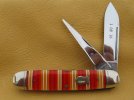
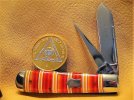
Dave
r8shell
Knifemaker / Craftsman / Service Provider
- Joined
- Jan 16, 2010
- Messages
- 25,825
I've heard that certain colors are less stable than others, but I haven't done much research on that.From what I read, the red/white or candy striped celluloid were some of the worst affected... something in the coloring or dye chemical accelerated the breakdown of the celluloid.
-Kevin
I've got a Standard Knife Co peanut that belonged to my grandfather that I'd like to have the cell replaced on someday, if I can find nice enough looking sparkly acrylic.
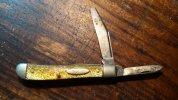
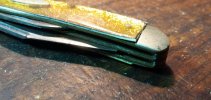
- Joined
- Nov 25, 2016
- Messages
- 3,149
I've heard that certain colors are less stable than others, but I haven't done much research on that.
I've got a Standard Knife Co peanut that belonged to my grandfather that I'd like to have the cell replaced on someday, if I can find nice enough looking sparkly acrylic.
View attachment 817559 View attachment 817560
Well that knife is likely over 100 years old and all the celluloid has done is shrink a little bit which is expected... so it looks like it's holding up pretty good. However, it would be neat to add your own twist to your grandfather's knife if you are worried about it possibly gassing and rusting
From what I read the clear celluloid is the worst because ultra-violet rays really accelerate the deterioration process and as mentioned some of the dye chemicals (red / white) accelerate it as well. However I also read that the ones dyed black are supposed to resist gassing better but I have seen some pictures posted today that would disprove that theory LoL. Again, I really think the biggest factor is how the celluloid was made and who made it... certain companies had specific procedures that they stuck to which involved a lengthy curing process that resulted in a more stable product. Other manufacturer's likely cheated that process in an effort to turn them out quicker.
-Kevin
- Joined
- Nov 25, 2016
- Messages
- 3,149
Bummer!
Fortunately these two still do!But they are by themselves and watched/admired closely!!
View attachment 817551
View attachment 817549
Dave
Great medallion Dave... congrats!
 It will be 4 years for me in a couple weeks, life is good
It will be 4 years for me in a couple weeks, life is good - Kevin
r8shell
Knifemaker / Craftsman / Service Provider
- Joined
- Jan 16, 2010
- Messages
- 25,825
The knife I posted with the shrunken black scales was a 1940s Camillus. It makes some sense that while manufacturing knives for WWII, longevity or appearance wasn't their first priority.However I also read that the ones dyed black are supposed to resist gassing better but I have seen some pictures posted today that would disprove that theory LoL. Again, I really think the biggest factor is how the celluloid was made and who made it... certain companies had specific procedures that they stuck to which involved a lengthy curing process that resulted in a more stable product. Other manufacturer's likely cheated that process in an effort to turn them out quicker.
- Joined
- Nov 25, 2016
- Messages
- 3,149
knowtracks
Gold Member
- Joined
- Jan 16, 2006
- Messages
- 3,891
Great medallion Dave... congrats!It will be 4 years for me in a couple weeks, life is good
Oh and the knives are pretty nice too LoL.
- Kevin
Congratulations Kevin!!
 The 6th of Jan I turn 20!
The 6th of Jan I turn 20! Knife content....

Charlie's knives and Charlie's scan!
Dave
Last edited:

